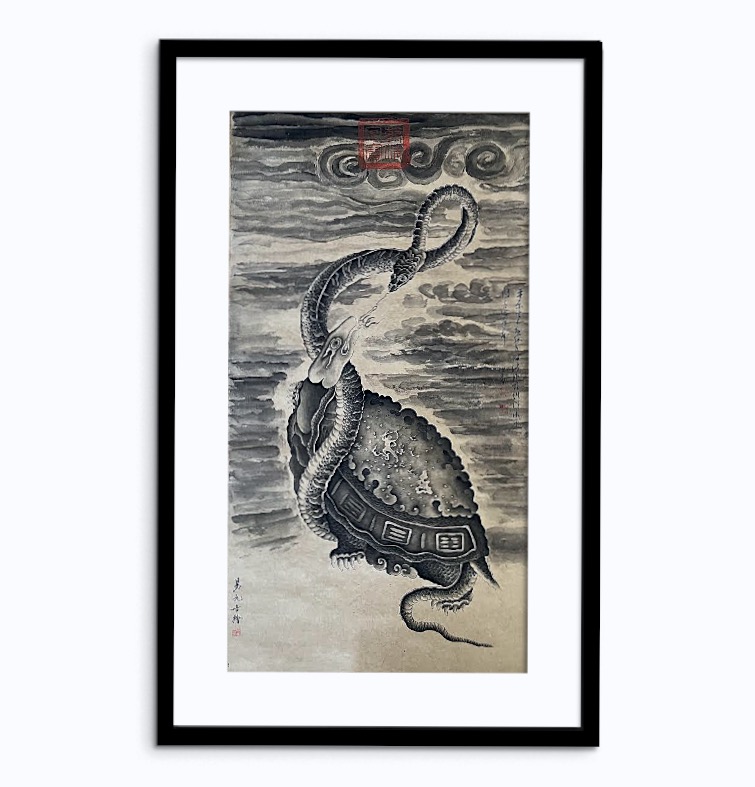

Title: Chinese Antique Ink Wash Watercolor Scroll Painting
Shipping: $29.00
Artist: N/A
Period: 20th Century
History: Art
Origin: Central Asia > China
Condition: Very Good
Item Date: N/A
Item ID: 400
A Wonderful original Chinese, antique Ink Wash Scroll painting of a tortoise and snake. Medium: Pen and Ink and wash / Image Size: 34 x 18 Inches / Date: Late 19th Early 20th Century / Condition: Very good original condition / This beautifully drawn Chinese scroll depicts Xuanu, the dark warrior who was an ancient deity in China / representing the North direction as a tortoise and snake. Zhenwu, the Perfected Warrior, emerged as an anthropomorphic deity in the early Northern Song (960-1126) and reached the peak of his popularity in the Ming (1368-1644). Prior to this time he was known as Xuanwu, the Dark Warrior, and appeared as a tortoise entwined with a snake. During the Han dynasty, people often wore jade pendants that were in the shape of turtles. Because of the ancient Chinese influence on Japan, honorific titles and badges in Japan also often referred to the turtle or tortoise. The northern gates of Chinese palaces were often named after the Xuanwu. In ancient China, the tortoise and the serpent were thought to be spiritual creatures symbolizing longevity. The min people custom of building turtle-shaped tombs may have had to do with the desire to place the grave under the influence of the Black Tortoise. In the classic novel Journey to the West, Xuanwu was a king of the north who had two generals serving under him, a "Tortoise General" and a "Snake General". This god had a temple in the Wudang Mountains of Hubei and there are now a "Tortoise Mountain" and a "Snake Mountain" on opposite sides of a river near Wuhan, Hubei's capital. Taoist legend has it that Xuanwu was the prince of a Chinese ruler but was not interested in taking the throne, opting instead to leave his parents at age 16 and study Taoism. According to the legend, he eventually achieved divine status and was worshiped as a deity of the northern sky.
Chinese mounting and conservation techniques are considered a traditional craft and are believed to have developed around 2,000 years ago. This craft is considered an art onto itself. Careful attention was and still is paid to ensure the quality and variety of the silk and paper to protect and properly fit the artwork onto the mounting, as it gives form to the art. The art is fixed onto a four-sided inlay, made from paper or silk, thus providing a border. A hanging scroll is one of the many traditional ways to display and exhibit East Asian painting and calligraphy. The hanging scroll was displayed in a room for appreciation; it is to be distinguished from the handscroll, which was narrower and designed to be viewed flat on a table in sections and then stored away again. The hanging scrolls are rotated according to season or occasion, and such works are never intended to be on permanent display. The painting surface of the paper or silk can be mounted with decorative brocade silk borders. In the composition of a hanging scroll, the foreground is usually at the bottom of the scroll while the middle and far distances are at the middle and top respectively. The traditional craft involved in creating a hanging scroll is considered an art in itself. Mountings for Chinese paintings can be divided into a few types, such as handscrolls, hanging scrolls, album leaves, and screens amongst others. In the hanging scroll the actual painting is mounted on paper, and provided at the top with a stave, to which is attached a hanging cord, and at the bottom with a roller. The earliest hanging scrolls are related to and developed from silk banners in early Chinese history. These banners were long and hung vertically on walls. Such silk banners and hanging scroll paintings were found at Mawangdui dating back to the Han dynasty (206 BCE – 220 CE). By the time of the Tang dynasty (618–907), the aesthetic and structural objectives for hanging scrolls were summarized, which are still followed to this day. During the early Song dynasty (960–1279), the scrolls became well suited to the art styles of the artists, consequently hanging scrolls were made in many different sizes and proportions. The Chinese, Ink Wash and Scroll is a roll of parchment or paper for writing or painting on. Scrolls were the first form of editable record-keeping texts. The ink used in writing scrolls had to adhere to a surface that was rolled and unrolled, so special inks were developed to hold up over time.